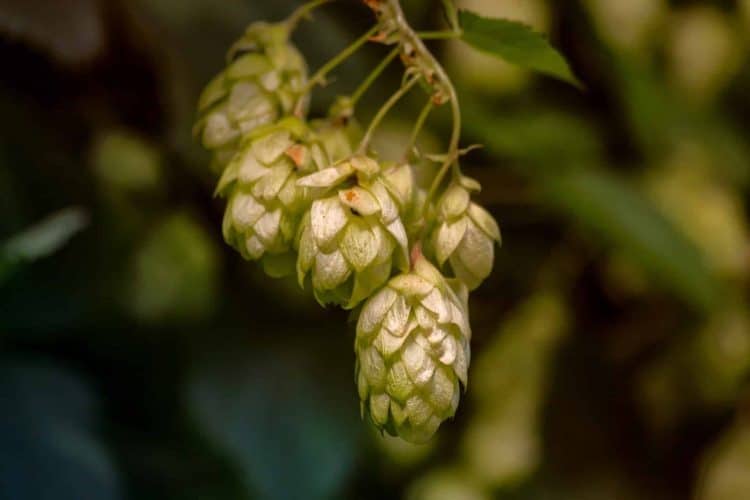Hop and cannabis run parallel in terms of extraction with few meaningful differences other than target compounds and extraction parameters.
Hop is a genus (Humulus) in the cannabis family (Cannabaceae); female flowers (cones) from H. lupulus (“hops”) undergo extraction and use by the brewing industry, adding flavor and aroma to beer. [1] Some of the key targets include α-acids (conferring bitterness), terpenes and their derivatives, and polyphenols, which “significantly contribute to beer quality.” Brewers may add hop extract after fermentation. [1] The variety of hop, aging, and terpenes are potential variables; geraniol and linalool are associated with floral/citrus notes, for example. [2] Cannabis belongs to its own genus (Cannabis), with cannabinoids and terpenes as primary extraction targets due to multitudinous therapeutic applications.
Steam distillation is the traditional method for fractionating terpenes from hops. [3] Newer strategies aimed at optimizing efficiency include microwave-assisted hydrodistillation, which uses microwave radiation to distill the essential oil from the plant material and water. [3,4] Organic solvents such as ethanol can be used to extract α-acids but may alter the extract’s phenolic profile and necessitate winterization. [3] Rather, supercritical carbon dioxide (CO2) is the most widely used technique; in fact, hops helped popularize commercial use of supercritical CO2 extraction. [3]
Temperature and pressure requirements for hop extraction vary according to target compounds, as with cannabis. Subcritical CO2 may be used to extract aromatic components, and temperatures exceeding 40° C may damage these compounds and isomerize α-acids. In a recent review of literature, Sanz et al [3] recommend “20–30 MPa and 40–50° C” for “both the bitter compounds and the volatiles.” Lower pressures are also viable (e.g., 8-12 MPa), and a multi-step process may be beneficial. Interestingly, while ethanol cosolvent appears to increase yield, it also elevates α-acid and reduces β-acid concentrations. [3]
Supercritical CO2 is a green solvent of choice for cannabis extraction with efficient, large-scale commercial viability. Testing different pressures (17-34 MPa) at 55° C (200 g/min), Rovetto & Aieta [5] determined 34 MPa to be the optimal pressure for efficiency; a pressure of 13 MPa generated the highest tetrahydrocannabinol (THC) potency, however. Greater efficiency may also be achieved by using an ethanol co-solvent. [5] As with hops, parameters may be adjusted to target certain compounds in cannabis.
Thus, the plants and their extraction processes are quite similar. A recent study in Food Chemistry illustrated that hemp extract in the form of essential oil can be used to flavor artisanal alcoholic beverages. [6] Beer has been brewed with cannabis terpenes, cannabinoids added to hops extract, and hops terpenes tossed into vape oil. The festive family get-together has proved to charm and delight.
References
- Roberts TR. “” Brewing Materials and Processes, ed. Bamforth C, 2016, pp.47–75,doi:10.1016/b978-0-12-799954-8.00003-4.
- Lam KC, et al. “Aging of Hops and their Contribution to Beer Flavor.” J Agric Food Chem, 34, no.4, 1986, pp.763–770. Impact Factor: 3.154; Times Cited: 52 (ACS)
- Sanz V, et al. “What is New on the Hop Extraction?” Trends in Food Science & Technology, vol.93, 2019, pp.12-22. Impact Factor: 8.519; Times Cited: N/A
- Rovetto L, Aieta N. “Supercritical Carbon Dioxide Extraction of Cannabinoids from Cannabis sativa L. Plant Material.” Journal of Supercritical Fluids, vol.129, 2017, pp.16-27. Impact Factor: 3.481; Times Cited: 20 (ResearchGate)
- Nitthiyah J, et al. “Microwave Assisted Hydrodistillation – An Overview of Mechanism and Heating Properties.” Aust J Basic & Appl Sci, vol.11, no.3, 2017, pp.22-29. Impact Factor: N/A; Times Cited: 5 (SemanticScholar)
- Ascrizzi R, et al. “‘Hemping’ the Drinks: Aromatizing Alcoholic Beverages with a Blend of Cannabis Sativa L. Flowers.” Food Chemistry, vol.325, 2020, p.126909, doi:https://doi.org/10.1016/j.foodchem.2020.126909. Impact Factor: 5.399; Times Cited: N/A
Image by klickblick from Pixabay











